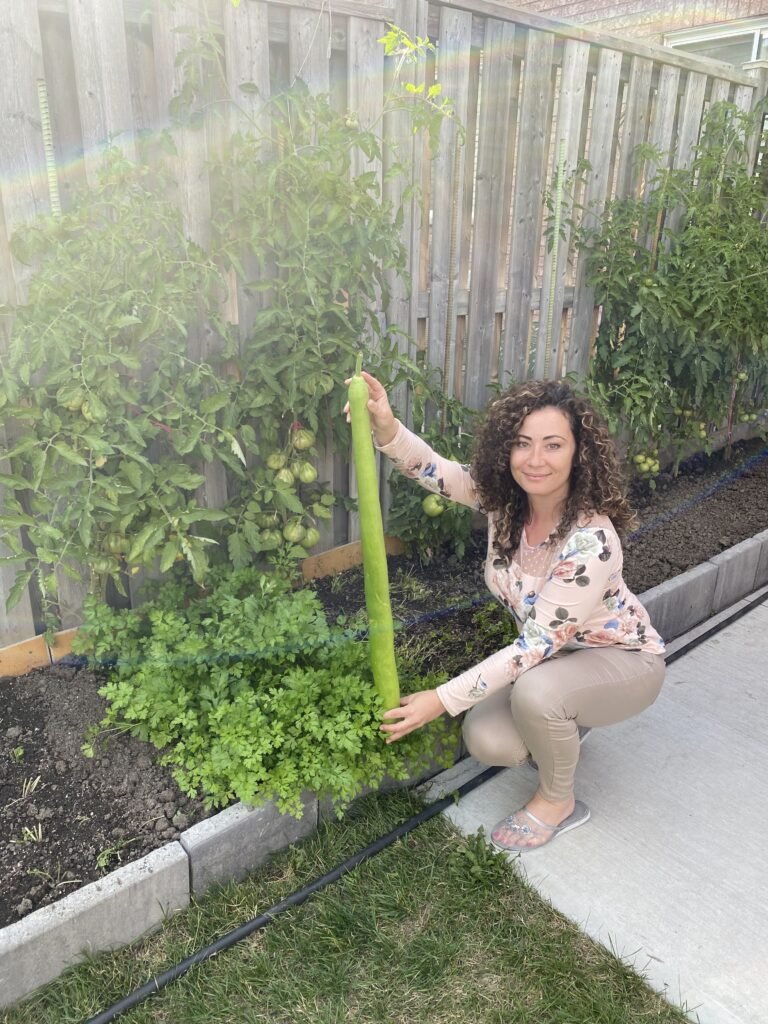How to Make Mamma Enza’s Cucuzza & Chickpea Stew?
Welcome my beautiful, strong and sexy Self-Care community to my blog post. In this post I will be sharing with you my mother’s Cucuzza (Sicilian squash) & chickpea stew recipe. I will share with you its nutritious value, benefits, history and some tips on how to grow it in your own vegetable garden.
Nutritional Facts
The Sicilian squash is similar to the Zucchini and is super low in calories, containing zero fat, high water and fiber content. Studies show that including at least 30 grams of fiber in your daily diet lowers your risk of getting diabetes significantly.
Even though it’s served as a vegetable, it’s technically a fruit because it comes from a flower, and you can also eat the blooms either stuffed or fried – and they’re so pretty as well.
Zucchini are very nutrient dense because they contain a significant amount of vitamins like B6, Riboflavin, Folate, powerful antioxidants like Vitamin C, E, and Vitamin K. They also contain healthful minerals including Potassium, Iron, Calcium, Magnesium, Phosphate, Copper, Manganese and Zinc. The good amount of Potassium found in a zucchini, can help control blood pressure because it balances the effects of salt in your body.
The summer squash also contains antioxidant and anti-inflammatory phytonutrients. Large amounts of these compounds are found in zucchini skin. For this reason, you should eat the skin together with the flesh as much as possible. Research has shown that squash seeds also contain traces of cancer-preventing substances, known as protease trypsin inhibitors, which inhibit activation of viruses and carcinogens in the digestive tract.

8 Benefits of this Nutrient Dense Vegetable
- Improves digestion due to its high water, fiber, electrolyte and other nutrients.
- Slows down aging due to its rich antioxidant and anti-inflammatory phytonutrients helping to combat free radicals.
- Lowers blood sugar levels and increase insulin sensitivity due to its high fiber content you feel full longer reducing your intake of processed carbohydrates.
- Supports healthy circulation & healthy heart due to its low fat and sodium content but high in fiber and potassium.
- Improves eye health due to it being a good source of health-protecting antioxidants and phytonutrients like Vitamin C, Beta-Carotene, Manganese, Zeaxanthin, and Lutein.
- Boost energy due to it being a rich source of B-vitamins especially Folate, Riboflavin, and B6 involved in energy production in the body.
- Weight loss because it is low in calories and its high in water and fiber keeping you satiated longer and helping you avoid snacking.
- Boost Immunity due to it being rich in antioxidants and anti-inflammatory compounds like Vitamin A, C, and Glutathione.
Origins of this Versatile Vegetable
According to the University of Arizona Cooperative Extension, archaeologists traced the origins of summer squash to Central America, ranging into Mexico and the northern parts of South America dating back to 5500 BC, where it was an integral part of the ancient diet. Within 50 years of the European colonization of the Americas, summer squash varieties were introduced in Europe. It is believed that the Italians then developed zucchini, giving it the name we now use. “Zucca” is actually the Italian word for squash, “Cucuzza” is dialect in many parts of southern Italy. When I was in Dubai the British call them Courgette.

This vegetable is so versatile, you can eat it raw by spiralizing it and using it as a pasta substitute in your favourite pasta dishes, you can steam it, bake it, grill it and even put it on the BBQ (cut it in strips and season with our favourite herbs). One of my favourite ways is to make a zucchini and eggplant lasagna. It can be part of a savoury dish or you can also bake it as a zucchini cake and satisfy your sweet tooth.
The Sicilian Cucuzza is rarely found in supermarkets, but in my Italian neighbourhood north of Toronto, you could find cucuzza growing in just about everyone’s vegetable garden. It’s as much as part of summer as making the annual tomato sauce. The Sicilian Cucuzza is huge, light green coloured, and can grow up to 3-4 feet long, usually sparking a competition among the men in the neighbourhood.

How to Grow Zucchini in Your Vegetable Garden?
Usually neighbours share their seeds from the previous year’s crop, because once you have a mature cucuzza, you can save some of the seeds and have a planting for the next season. Zucchini in general are very easy to grow. Usually planted in May-June depending on weather conditions and again in late August, allowing for two harvests per year. Optimal conditions for planting zucchini include the right location, proper soil preparation, and favorable temperatures. Being tropical in origin, summer squash is a frost-sensitive annual plant; temperatures over 70 degrees Fahrenheit or 21 degrees Celsius are favorable for growth and development. Sunlight is essential, so locate plants in an area that receives 6 to 10 hours daily. Make sure you have lots of room because they definitely need it.
Harvest zucchini as you need them when they are about six inches long. Fruits taste best at this stage. If you let them to grow for too long, they start getting woody and won’t taste too good. The variations of making dishes with zucchini are endless, my suggestion is to choose your favourite vegetable that is in season and add that as the main companion to your zucchini dish.
Check out my mother’s Cucuzza & Chickpea Stew recipe, here. You can also make a delicious spinach risotto, and roasted butternut squash.
Buon Appetito 🍷
References:
https://cals.arizona.edu/maricopa/garden/html/pubs/0403/zucchini.html

